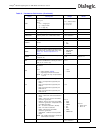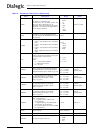
33
Dialogic
®
SS7G2x Signaling Server SGW Mode User Manual Issue 4
LS1
Primary link set associated with an SS7
route
1 to 64
LS2
Secondary linkset associated with an SS7
route
1 to 64
LSSIZE
Maximum number of SS7 links allowed in
the link set. The link set size is used to
determine the load sharing algorithm used
across the link set.
1 to 16
M56K
56kbits signaling mode:
• 0 - 64 kbits/s used
• 1 - 56kbits/s enabled (bit 8 not used)
• 2 - 48kbits/s enabled (bits 7 and 8 not
used)
• 3 - Recover clock from V.11 interface
• 4 - Transmit clock to V.11 interface
0 to 4
Default = 0
M56K modes 3 and
4 can only be set on
boards with
SIGTYPE = SS7
MASK
IP network mask specified using dot
notation, that is, www.xxx.yyy.zzz
www – 0 to 255
xxx – 0 to 255
yyy – 0 to 255
zzz – 0 to 255
MINREC
The minimum number of records held by
the Signaling Gateway before transfer
100 to 200
NA Network appearance 0 to 2147483647
NASP
Number of ASP required in load sharing
mode
0 to 32 Default = 0
NC Signaling Gateway SS7 network context 1 to 4
NI Network Indicator for an SS7 link set 0 to 3
OPC SS7 Originating Point Code 0 to 16777215
OTS
The output timeslot in a cross connection
(in the case of a duplex cross connection,
this is also the input timeslot for the reverse
direction). The format is:
xx-y-zz
where:
• xx = board position (BPOS)
• y = PCM within a board
• zz = Timeslot
xx – 1 to 3
y – 1 to 4
zz – 1 to 31
PAGE The page of data to be printed 1 to 10 Default = 1
PARITY
Parity option on V.24 port.
Affects transmit parity only, parity is
ignored on receive.
One of:
• ODD
•EVEN
•NONE
Default = NONE
PASSWORD
Used to specify the password for either
remote login access or to provide password
control for Signaling Gateway MML
0 to 12
<text character>
PCM
PCM interface on a board in the format:
xx-y
where:
• xx = board position (BPOS)
• y = PCM within a board
xx – 1 to 3
y – 1 to 4
PCMD
Application Server Point Code mode:
• ANY – If any Application Server is in
service then the Point Code the
Application Server exists within is
considered to be up.
• ALL – Only when all the Application
Servers within a Point Code are in
service will the Point Code they exist
within be considered to be up.
One of:
•ANY
• ALL
Table 2. Parameter Definitions (Continued)
Name Description Range Notes


















